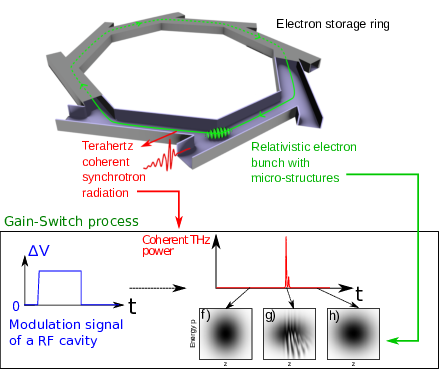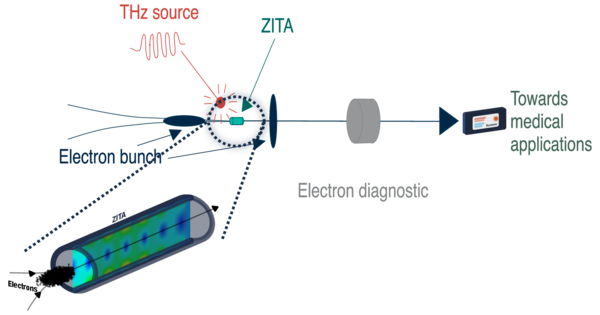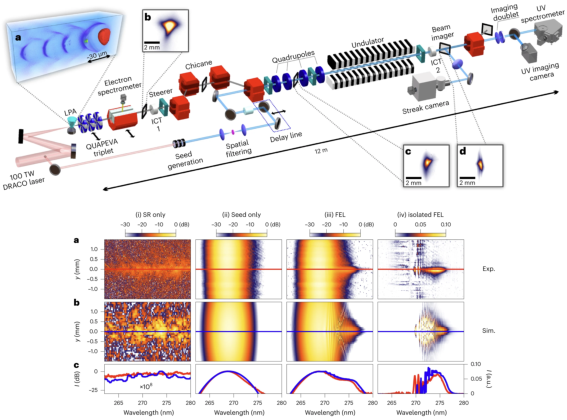III. Dynamics of Accelerators
Researchers: Serge BIELAWSKI, Clément EVAIN, Eléonore ROUSSEL, Christophe SZWAJ
PhDs and postdocs: Quentin DEMAZEUX, Christelle HANOUN
The general objective of the group’s activity is to contribute to important problems in accelerator physics, when possible, using original approaches from the PhLAM background. This activity strongly relies on collaborations with accelerator teams in France and abroad. The scope of the activity, which started in 2003 (initially on the topics of free-electron laser dynamics), has thus naturally evolved several times. From the conceptual point of view, recent activities concerned the accelerator dynamics, the photonics-accelerator interface, and the emerging field of compact accelerators.
Synchrotron radiation facilities (and accelerators in general) are subjected to dynamical instabilities. The group’s strategy has been to create a consortium on the topics, with SOLEIL and KARA (Germany), in order to explore complementary approaches. The Lille’s focus has been made on original methods based on “chaos control”, a typical expertise of the DYSCO team. After the first demonstration of the method, detailed studies have been performed, during the ULTRASYNC ANR-DFG project (led by PhLAM). This activity also required a combined work on numerical investigations, as well as ultrafast measurements (see next section).

Figure 1 Control of the electron bunch dynamics - inspired by the process of gain switching in lasers – to trigger the formation of microstructures in the relativistic electorn bunches and produce giant coherent terahertz bursts (see PRL-2024 for details). The amplitude ∆V of the rf cavities in zero-crossing mode is modulated with a pseudorectangular signal, and with adequate parameters (bunch current, duration and amplitude of ΔV), the appearance of structures in the bunch phase-space (f-h) can be triggered and enhanced during a short time, leading to the emission of a high THz coherent burst (red cuvre).
Initially, this activity has been required by the studies and control of instabilities in synchrotron radiation facilities. However, we noticed an increasing demand in ultrafast measurements techniques from many accelerator groups worldwide. Such measurements turned out to be required for monitoring the electron bunches in accelerators, or the light emitted by light sources (such as Free-Electron Lasers or synchrotron radiation facilities). The requirements are stringent, necessitating pico/subpicosecond time resolution, MHz+ acquisition rates, single-shot and real-time operation, as well as the capability to operate in accelerator environments.
The adequacy of the team’s expertise in the field (with previous experience in THz measurements) motivated us to try solving open measurements challenges. Several achievements in THz ultrafast measurements, in particular the novel conceptual approach, illustrated in the figure below, published in the team’s Nature/LSA article in 2022 (with a demonstration at FERMI in 2023) placed the team in a position of leader. Close collaboration with SOLEIL (France) and KARA (Germany) has been specifically supported by the ULTRASYNC ANR-DFG project (led by PhLAM).
The group is currently receiving demands for joined experiments and/or advice from a number of facilities. We thus had to choose a collaboration strategy, and decided to reinforce the collaboration on ultrafast measurements in two contexts:
-
Within the TWAC EIC project (see below)
-
We also established a Frame Cooperation Agreement between CNRS and DESY (who is hosting FLASH and European XFEL) on this topic
Figure 2 Electron bunch shapes recorded at the European X-ray Free-Electron Laser (EuXFEL). a Picture from inside the 3 km-long accelerator tunnel. Our detection setup is placed just upstream of the picture, after the first bunch compressor. b Diversity Electro-Optic Samping (DEOS) setup. A laser beam probes the electric field at a distance D = 5 mm from the electron beam. c Electro-optic signals of a single bunch before reconstruction. d Reconstructed electric field. Shaded areas: superposition of single-shot curves, color curves: average over 255 bursts. e Electro-optic signal of two bursts (i.e., 800 electron bunches in total). f Shape of one bunch (with bunch number 200 within the burst) versus burst number. g Arrival time versus bunch number. Shaded areas: RMS arrival time fluctuations, color curve: average over 255 bursts. The EO data are low-pass filtered to 2.5 THz. (Figures adapted from LSA-2022).
The objective of the TWAC project is to explore novel acceleration methods, using THz waves, with the aim to study the feasibility of compact accelerators, with few cm length. The consortium is composed of IJCLAB (Orsay, the project leader), Pecs University (Hungary, Janos Hebling’s group), DESY (Germany), CSIC (Spain), PhLAM, and two private companies. The PhLAM team is committed to the realization of the required cutting-edge diagnostics (using the experience described in previous section). The team is also engaged in the fundamental aspects of the THz acceleration process, encompassing numerical studies of its mechanisms.
-
Conventional FEL on standard radio-frequency linear accelerator
A hot topic of the free-electron laser (FEL) community concerns the development of ultra-short coherent pulses in the x-ray domain. The team’s expertise in FEL dynamics and background in nonlinear optics together with a close collaboration with the FERMI facility (Italy) permits an original investigation of the understanding and control of electron beam instabilities in linear accelerators aiming at improving the coherence of FEL; and to explore new seeding schemes and FEL operational modes enabling experiments that can take full advantage of the coherence of FERMI FEL pulses. PhLAM has contributed to the first demonstration of coherent soft x-ray pulses using highly nonlinear harmonic conversion strategy in relativistic electron bunches (Nature Photonics 2019) and is currently contributing to the commissioning of the new FERMI FEL1 line.
Figure 4 Coherent soft X-ray pulses from an echo-enabled harmonic generation (EEHG) FEL. A first seed laser induces a sinusoidal energy modulation at the seed wavelength lambda1 which is then rotated in the phase-space thanks to a magnetic chicane, leading to the formation of energy stripes in the phase-space. The electron energy is periodicaly modulated at lambda2 using a second seed laser in a second modulator. After passing thourgh a second weak chicane, the phase-space is rotated, transforming the sinusoidal energy modulation into a periodic density modulation with high-frequency contents. This fine structure of a few nanometers leads to the emission of coherent FEL radiation whose wavelength is a mixing of the two seed wavelengths according to the formula 1/lambdaFEL = m/lambda1 + n/lambda2, with m and n positve or negative integers. The left plot shows the spectrum at 3.1 nm (harmonic 84) starting from two seed wavelengths at 264 nm (Figures adapted from Nat. Photonics 2019).
- FEL based on laser-plasma accelerator
The COXINEL project, led by Synchrotron SOLEIL (in collaboration with LOA, France and HZDR, Germany) aimed to demonstrate the FEL amplification using an advanced compact accelerator based on laser-plasma acceleration. The PhLAM team, thanks to its expertise on the photonics-accelerator interface, actively contributed to the control of this new light source installation with several milestones achieved consecutively such as the manipulation of the electron beam generated by this new type of compact accelerator until the first demonstration of coherent seeded FEL achieved in 2022 (Nature Photonics 2023).
Figure 5 The seed FEL on the COXINEL line (developed by Synchrotron SOLEIL) combined to the laser-plasma accelerator driven by the DRACO laser from HZDR (Dresden, Germany). Due to the intrinsic beam properties of the LPA beam, the FEL radiation appears red-shifted with respect to the seed laser wavelength. The fundamental mechanism leading to the redshift has been described in NJP-2020. Firgures from Nat. Photonics 2023.




